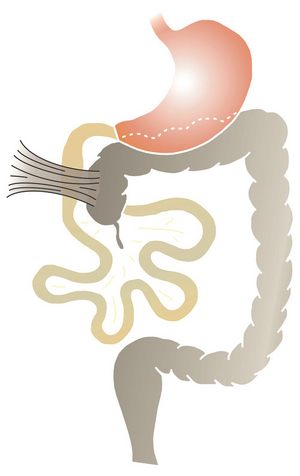Small Intestine Obstruction (Pediatrics)
From WikiLectures
(Redirected from Small Intestine Obstruction)
There are several causes of small intestine obstruction:
- Atresia – the intestine ends with blind end and after variably long atresic part, the distal part is opened. May be caused by intrauterine vessel malfunction of the intestine with subsequent gangrene. Gangrene is then resorbed and atresia develops.
- Meconium ileus – obstruction caused by meconium.
- Some cases of Hirschprung's disease (megacolon congenitum) may affect small intestine.
- Extraintestinal causes – malrotation, collagen dysfunctions, hernia, calcificated lymphatic nodes, duplicatures, omphalocela.
Duodenal obstruction
- It belongs to the so-called proximal intestinal obstructions - these are characterized by - minor distension of the abdomen and permanent explosive vomiting.
 Ladd's Syndrome - unrotated cecum and duodenal compression by peritoneal bands.
Ladd's Syndrome - unrotated cecum and duodenal compression by peritoneal bands. - In the case of intestinal obstruction below the level of 15 cm from the beginning of the jejunum - the so-called distal obstruction - bloating, distension of the abdomen dominates, vomiting comes later.
- Obstruction of the duodenum can be caused by atresia (more often) or stenosis.
- It is more common in Down syndrome and in immature children.
- The obstruction is usually located below the major papilla of the duodenum.
- Otherwise, obstruction can also occur with incomplete rotation of the intestine, volvulus congenitalis, with pancreas annulare.
- Clinical picture:
- Obstruction of the duodenum is closely related to the circulation of amniotic fluid - in all cases of obstruction, polyhydramnios is detected during childbirth .
- Therefore, every time polyhydramnios is found, we have to aspirate the stomach contents with a tube after birth - and if it is more than 15 ml, we suspect proximal intestinal obstruction.
- The main symptom – projectile vomiting (with atresia it starts immediately after birth, with stenosis after several hours).
- Vomit is a yellowish admixture of bile.
- Sometimes we see a peristaltic wave similar to that of pylorostenosis.
- Distention - only in the epigastrium or absent.
- Laboratory – hypochloremic alkalosis, Na + and K + depletion;
- Diagnosis - ultrasound can be detected already intrauterine.
- After birth, the best native x-ray image of the abdomen in the hanging position (the contrast material is air swallowed by the baby) at the time of birth.
- Normally - immediately after birth, there should be air in the stomach, within 1 hour in the small intestine, in 4-18 hours in the large intestine.
- With atresia, the typical picture is of "two bubbles" - one in the stomach area, the other smaller one in the duodenum area.
- After birth, the best native x-ray image of the abdomen in the hanging position (the contrast material is air swallowed by the baby) at the time of birth.
- Therapy – surgical – duodenoplasty, duodenojejunostomy,
- prior to the operation, modification of the internal environment is necessary.
Links
Related Articles
Source
- BENEŠ, Jiří. Studijní materiály [online]. ©2007. [cit. 2010-04]. <http://www.jirben.wz.cz/>.
Bibliography
- HRODEK, Otto – VAVŘINEC, Jan, et al. Pediatrie. 1. edition. Praha : Galén, 2002. ISBN 80-7262-178-5.
- ŠAŠINKA, Miroslav – ŠAGÁT, Tibor – KOVÁCS, László, et al. Pediatria. 2. edition. Herba, 2007. ISBN 978-80-89171-49-1.
</noinclude>
Links
Related articles
Source
- BENEŠ, Jiří. Studijní materiály [online]. ©2007. [cit. 2010-04]. <http://www.jirben.wz.cz/>.
Used literature
- HRODEK, Otto – VAVŘINEC, Jan, et al. Pediatrie. 1. edition. Praha : Galén, 2002. ISBN 80-7262-178-5.
- ŠAŠINKA, Miroslav – ŠAGÁT, Tibor – KOVÁCS, László, et al. Pediatria. 2. edition. Bratislava : Herba, 2007. ISBN 978-80-89171-49-1.

